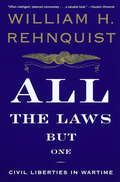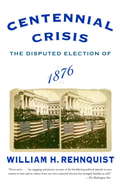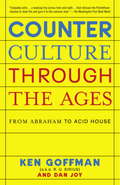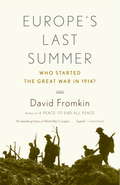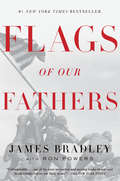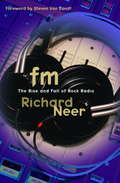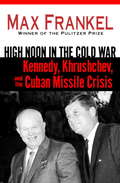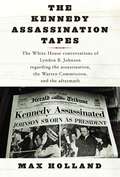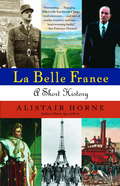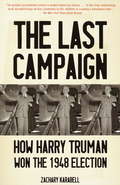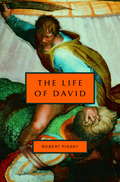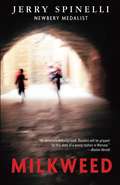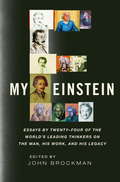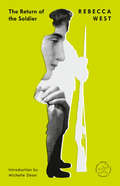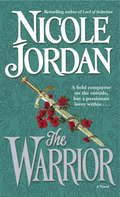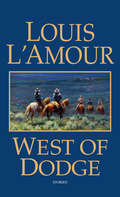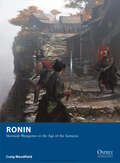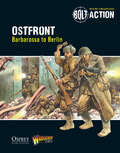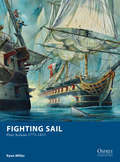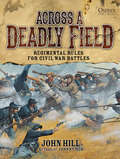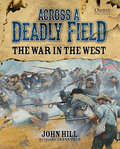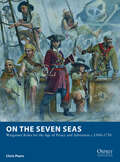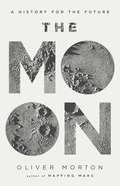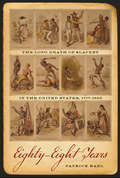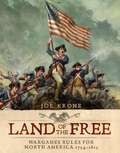- Table View
- List View
All the Laws but One
by William H. RehnquistInAll the Laws but One, William H. Rehnquist, Chief Justice of the United States, provides an insightful and fascinating account of the history of civil liberties during wartime and illuminates the cases where presidents have suspended the law in the name of national security. Abraham Lincoln, champion of freedom and the rights of man, suspended the writ of habeas corpus early in the Civil War--later in the war he also imposed limits upon freedom of speech and the press and demanded that political criminals be tried in military courts. During World War II, the government forced 100,000 U. S. residents of Japanese descent, including many citizens, into detainment camps. Through these and other incidents Chief Justice Rehnquist brilliantly probes the issues at stake in the balance between the national interest and personal freedoms. WithAll the Laws but Onehe significantly enlarges our understanding of how the Supreme Court has interpreted the Constitution during past periods of national crisis--and draws guidelines for how it should do so in the future.
Centennial Crisis
by William H. RehnquistNear midnight on Election Day in November 1876, the returns coming into Republican National headquarters signaled a victory for the Democratic presidential candidate, Samuel J. Tilden. But alert Republican leaders saw that if all the states still doubtful or disputed went for their candidate, Rutherford B. Hayes would be elected. Word was sent out to four southern states that their returns were crucial for a Hayes victory. Thus Chief Justice William Rehnquist begins this remarkable account of one of American's greatest political dramas, a crisis that was not resolved for nearly four months, on March 2, 1877, only two days before Inauguration Day. In his gripping story, Rehnquist tells how each party maneuvered to buy votes in the southern states, how the country slid into Congressional, judicial and public turmoil, and how the creation in January of an Electoral Commission (comprised of five Democrats, five Republicans and five Supreme Court justices) was opposed by both candidates. When that body's deciding vote was cast by Justice Joseph Bradley, public outcry reached such a fever pitch that the presidential swearing-in had to be held on a Sunday in near secrecry. Reaching beyond the history of a contentious election, the Chief Justice describes the political climate and economy of America in the 1870's, packing his narrative with biographical sketches of the central participants and opening a window on events in that decade that have long been overlooked. In a compelling epilogue we learn the occasions when Presidents, ranging from George Washington to Lyndon Johnson, have asked Supreme Court justices to arbitrate disputes, settle treaties or serve on investigating commissions. Almost always the justices were berated and attacked for their decisions. Would it be better for them to have refused the president’s request? The Chief Justice has some surprising answers.
Counterculture Through the Ages
by Ken Goffman Dan JoyAs long as there has been culture, there has been counterculture. At times it moves deep below the surface of things, a stealth mode of being all but invisible to the dominant paradigm; at other times it’s in plain sight, challenging the status quo; and at still other times it erupts in a fiery burst of creative–or destructive–energy to change the world forever. But until now the countercultural phenomenon has been one of history’s great blind spots. Individual countercultures have been explored, but never before has a book set out to demonstrate the recurring nature of counterculturalism across all times and societies, and to illustrate its dynamic role in the continuous evolution of human values and cultures. Countercultural pundit and cyberguru R. U. Sirius brilliantly sets the record straight in this colorful, anecdotal, and wide-ranging study based on ideas developed by the late Timothy Leary with Dan Joy. With a distinctive mix of scholarly erudition and gonzo passion, Sirius and Joy identify the distinguishing characteristics of countercultures, delving into history and myth to establish beyond doubt that, for all their surface differences, countercultures share important underlying principles: individualism, anti-authoritarianism, and a belief in the possibility of personal and social transformation. Ranging from the Socratic counterculture of ancient Athens and the outsider movements of Judaism, which left indelible marks on Western culture, to the Taoist, Sufi, and Zen Buddhist countercultures, which were equally influential in the East, to the famous countercultural moments of the last century–Paris in the twenties, Haight-Ashbury in the sixties, Tropicalismo, women’s liberation, punk rock–to the cutting-edge countercultures of the twenty-first century, which combine science, art, music, technology, politics, and religion in astonishing (and sometimes disturbing) new ways, Counterculture Through the Ages is an indispensable guidebook to where we’ve been . . . and where we’re going.
Europe's Last Summer: Who Started the Great War in 1914?
by David FromkinThe Great War not only destroyed the lives of over twenty million soldiers and civilians, it also ushered in a century of huge political and social upheaval, led directly to the Second World War and altered for ever the mechanisms of governments. And yet its causes, both long term and immediate, have continued to be shrouded in mystery. In EUROPE'S LAST SUMMER, David Fromkin reveals a new pattern in the happenings of that fateful July and August, which leads in unexpected directions. Rather than one war, starting with the assassination of Archduke Franz Ferdinand, he sees two conflicts, related but not inseparably linked, whose management drew Europe and the world into what The Economist described as early as 1914 as 'perhaps the greatest tragedy in human history'.
Flags of Our Fathers: A Young People's Edition (Playaway Adult Nonfiction Ser.)
by James Bradley Ron PowersIn this unforgettable chronicle of perhaps the most famous moment in American military history, James Bradley has captured the glory, the triumph, the heartbreak, and the legacy of the six men who raised the flag at Iwo Jima. Here is the true story behind the immortal photograph that has come to symbolize the courage and indomitable will of America. In February 1945, American Marines plunged into the surf at Iwo Jima—and into history. Through a hail of machine-gun and mortar fire that left the beaches strewn with comrades, they battled to the island's highest peak. And after climbing through a landscape of hell itself, they raised a flag. Now the son of one of the flagraisers has written a powerful account of six very different young men who came together in a moment that will live forever. To his family, John Bradley never spoke of the photograph or the war. But after his death at age seventy, his family discovered closed boxes of letters and photos. InFlags of Our Fathers, James Bradley draws on those documents to retrace the lives of his father and the men of Easy Company. Following these men's paths to Iwo Jima, James Bradley has written a classic story of the heroic battle for the Pacific's most crucial island—an island riddled with Japanese tunnels and 22,000 fanatic defenders who would fight to the last man. But perhaps the most interesting part of the story is what happened after the victory. The men in the photo—three were killed during the battle—were proclaimed heroes and flown home, to become reluctant symbols. For two of them, the adulation was shattering. Only James Bradley's father truly survived, displaying no copy of the famous photograph in his home, telling his son only: "The real heroes of Iwo Jima were the guys who didn't come back. " Few books ever have captured the complexity and furor of war and its aftermath as well asFlags of Our Fathers. A penetrating, epic look at a generation at war, this is history told with keen insight, enormous honesty, and the passion of a son paying homage to his father. It is the story of the difference between truth and myth, the meaning of being a hero, and the essence of the human experience of war.
Fm
by Richard Neer"It was all so honest, before the end of our collective innocence. Top Forty jocks screamed and yelled and sounded mightier than God on millions of transistor radios. But on FM radio it was all spun out for only you. On a golden web by a master weaver driven by fifty thousand magical watts of crystal clear power . . . before the days of trashy, hedonistic dumbspeak and disposable three-minute ditties . . . in the days where rock lived at many addresses in many cities. " -from FM As a young man, Richard Neer dreamed of landing a job at WNEW in New York-one of the revolutionary FM stations across the country that were changing the face of radio by rejecting strict formatting and letting disc jockeys play whatever they wanted. He felt that when he got there, he'd have made the big time. Little did he know he'd have shaped rock history as well. FM: The Rise and Fall of Rock Radio chronicles the birth, growth, and death of free-form rock-and-roll radio through the stories of the movement's flagship stations. In the late sixties and early seventies-at stations like KSAN in San Francisco, WBCN in Boston, WMMR in Philadelphia, KMET in Los Angeles, WNEW, and others-disc jockeys became the gatekeepers, critics, and gurus of new music. Jocks like Scott Muni, Vin Scelsa, Jonathan Schwartz, and Neer developed loyal followings and had incredible influence on their listeners and on the early careers of artists such as Bruce Springsteen, Genesis, the Cars, and many others. Full of fascinating firsthand stories, FM documents the commodification of an iconoclastic phenomenon, revealing how counterculture was coopted and consumed by the mainstream. Richard Neer was an eyewitness to, and participant in, this history. FM is the tale of his exhilarating ride. From the Hardcover edition.
High Noon in the Cold War
by Max FrankelOne of the giants of American journalism now re-creates an unforgettable time–in which the whole world feared extinction. High Noon in the Cold Warcaptures the Cuban Missile Crisis in a new light, from inside the hearts and minds of the famous men who provoked and, in the nick of time, resolved the confrontation. Using his personal memories of covering the conflict, and gathering evidence from recent records and new scholarship and testimony, Max Frankel corrects widely held misconceptions about the game of “nuclear chicken” played by John Kennedy and Nikita Khrushchev in October 1962, when Soviet missiles were secretly planted in Cuba and aimed at the United States. High Noon in the Cold Warportrays an embattled young American presidentnot jaunty and callow as widely believed, but increasingly calm and statesmanlikeand a Russian ruler who was not only a “wily old peasant” but an insecure belligerent desperate to achieve credibility. Here, too, are forgotten heroes like John McCone, the conservative Republican CIA head whose intuition made him a crucial figure in White House debates. In detailing the disastrous miscalculations of the two superpowers (the U. S. thought the Soviets would never deploy missiles to Cuba; the Soviets thought the U. S. would have to acquiesce) and how Kennedy and Khrushchev beat back hotheads in their own councils, this fascinating book re-creates thewholestory of the scariest encounter of the Cold War, as told by a master reporter.
The Kennedy Assassination Tapes
by Max HollandA major work of documentary history–the brilliantly edited and annotated transcripts, most of them never before published, of the presidential conversations of Lyndon B. Johnson regarding the Kennedy assassination and its aftermath. The transition from John F. Kennedy to Johnson was arguably the most wrenching and, ultimately, one of the most bitter in the nation’s history. As Johnson himself said later, “I took the oath, I became president. But for millions of Americans I was still illegitimate, a naked man with no presidential covering, a pretender to the throne…. The whole thing was almost unbearable. ” In this book, Max Holland, a leading authority on the assassination and longtime Washington journalist, presents the momentous telephone calls President Johnson made and received as he sought to stabilize the country and keep the government functioning in the wake of November 22, 1963. The transcripts begin on the day of the assassination, and reveal the often chaotic activity behind the scenes as a nation in shock struggled to come to terms with the momentous events. The transcripts illuminate Johnson’s relationship with Robert F. Kennedy, which flared instantly into animosity; the genuine warmth of his dealings with Jacqueline Kennedy; his contact with the FBI and CIA directors; and the advice he sought from friends and mentors as he wrestled with the painful transition. We eavesdrop on all the conversations–including those with leading journalists–that persuaded Johnson to abandon his initial plan to let Texas authorities investigate the assassination. Instead, we observe how he abruptly established a federal commission headed by a very reluctant chief justice of the Supreme Court, Earl Warren. We also learn how Johnson cajoled and drafted other prominent men–among them Senator Richard Russell (who detested Warren), Allen Dulles, John McCloy, and Gerald Ford–into serving. We see a sudden president under unimaginable pressure, contending with media frenzy and speculation on a worldwide scale. We witness the flow of inaccurate information–some of it from J. Edgar Hoover–amid rumors and theories about foreign involvement. And we glimpse Johnson addressing the mounting criticism of the Warren Commission after it released its still-controversial report in September 1964. The conversations rendered here are nearly verbatim, and have never been explained so thoroughly. No passages have been deleted except when they veered from the subject. Brought together with Holland’s commentaries, they make riveting, hugely revelatory reading.
La Belle France
by Alistair HorneLa Belle Franceis a sweeping, grand narrative written with all the verve, erudition, and vividness that are the hallmarks of the acclaimed British historian Alistair Horne. It recounts the hugely absorbing story of the country that has contributed to the world so much talent, style, and political innovation. Beginning with Julius Caesar’s division of Gaul into three parts, Horne leads us through the ages from Charlemagne to Chirac, touring battlefields from the Hundred Years’ War to Indochina and Algeria, and giving us luminous portraits of the nation’s leaders, philosophers, writers, artists, and composers. This is a captivating, beautifully illustrated, and comprehensive yet concise history of France. From the Trade Paperback edition.
The Last Campaign
by Zachary KarabellIn the presidential campaign of 1948, Americans had a choice across the ideological spectrum, from the far Right to the far Left. This account tells the story of all four candidates' campaigns, and argues that this was the last time a presidential race was dominated by radio and print media, and the last time that progressive and Left points of view were debated and covered in the mainstream press. The author has taught at Harvard, the University of Massachusetts, and Dartmouth. His essays have appeared in newspapers and national publications. Annotation c. Book News, Inc. , Portland, OR (booknews. com)
The Life of David
by Robert PinskyPoet, warrior, and king, David has loomed large in myth and legend through the centuries, and he continues to haunt our collective imagination, his flaws and inconsistencies making him the most approachable of biblical heroes. Robert Pinsky, former poet laureate of the United States, plumbs the depths of David’s life: his triumphs and his failures, his charm and his cruelty, his divine destiny and his human humiliations. Drawing on the biblical chronicle of David’s life as well as on the later commentaries and the Psalms——traditionally considered to be David’s own words——Pinsky teases apart the many strands of David’s story and reweaves them into a glorious narrative. Under the clarifying and captivating light of Pinsky’s erudition and imagination, and his mastery of image and expression, King David——both the man and the idea of the man——is brought brilliantly to life. From the Hardcover edition.
Milkweed
by Jerry SpinelliHe's a boy called Jew. Gypsy. Stopthief. Runt. Happy. Fast. Filthy son of Abraham. He's a boy who lives in the streets of Warsaw. He's a boy who steals food for himself and the other orphans. He's a boy who believes in bread, and mothers, and angels. He's a boy who wants to be a Nazi some day, with tall shiny jackboots and a gleaming Eagle hat of his own. Until the day that suddenly makes him change his mind. And when the trains come to empty the Jews from the ghetto of the damned, he's a boy who realizes it's safest of all to be nobody. Newbery Medalist Jerry Spinelli takes us to one of the most devastating settings imaginable-- Nazi-occupied Warsaw of World War II-- and tells a tale of heartbreak, hope, and survival through the bright eyes of a young orphan. "From the Hardcover edition. "
My Einstein
by John BrockmanIn this fascinating volume, today’s foremost scientists discuss their own versions and visions of Einstein: how he has influenced their worldviews, their ideas, their science, and their professional and personal lives. These twenty-four essays are a testament to the power of scientific legacy and are essential reading for scientist and layperson alike. Contributors include: • Roger Highfield on the Einstein myth • John Archibald Wheeler on his meetings with Einstein • Gino C. Segrè, Lee Smolin, and Anton Zeilinger on Einstein’s difficulties with quantum theory • Leon M. Lederman on the special theory of relativity • Frank J. Tipler on why Einstein should be seen as a scientific reactionary rather than a scientific revolutionary
The Return of the Soldier (Modern Library Torchbearers)
by Rebecca WestReprint of West's 1918 short novel of war, amnesia, manners. Cited in Annotation c. Book News, Inc. , Portland, OR (booknews. com)
The Warrior
by Nicole JordanBestselling author Nicole Jordan weaves a breathtakingly sensuous story of love and passion between the valiant Ariane of Claredon and the fierce knight who loses his heart to her. . . . For five turbulent years Ariane has dutifully prepared herself for marriage to King Henry’s most trusted vassal, the legendary Norman knight Ranulf de Vernay. But cruel circumstance has branded Ariane’s father a traitor to the crown. And now Ranulf is returning to Claredon, not as a bridegroom . . . but as a conqueror. Survivor of a hellish youth, Ranulf knows well the treacheries of noblewomen–and mistrusts the regal, defiant beauty to whom he was once betrothed. But while he shields his wounded heart with impenetrable armor, she sears his soul with sensuous fire. Ranulf may have vowed to claim her lands and her body as his prize, but ultimately it is the mighty warrior who must surrender to Ariane’s proud, determined passion–and her remarkable healing love. From the Paperback edition.
West of Dodge
by Louis L'AmourWhere the real frontier begins...A young cowpuncher stakes a claim that can only be sealed with fists and a .44 Colt.... A gunfighter, tired of violence, finds himself pushed down a trail of bloody revenge.... From purple sage to gambler's gold, from a señorita's tempting smile to a splash of blood in the dust, here are stories with a distinctive L'Amour twist.A quiet farmer defends his honor in a moment of panic and luck...only to find true courage on the run from the dead man's brothers. A young drifter defends a lady's honor...and finds himself the quarry of a hanging posse. An aging marshal with a reputation as a crack shot faces a stranger who knows his secret. With relentless suspense and unforgettable drama, Louis L'Amour once again paints a vivid portrait of our western heritage that will live forever.From the Paperback edition.
Ronin - Skirmish Wargames in the Age of the Samurai
by Craig Woodfield Jose Daniel PenaRonin is a set of skirmish wargame rules set in late 16th century feudal Japan. Players build small warbands of models and battle each other as well as non-player factions in duels and skirmishes. Ronin is historically accurate, but also pays tribute to the films of Akira Kurosawa such as Seven Samurai and Yojimbo.Despite the enduring popularity of this period, there are very few widely available historical samurai skirmish wargames rules sets. Figures for the period are increasingly available, particularly from Perry Miniatures (very high quality 28mm metal), Wargames Factory (plastic 28mm box sets) and Zvezda (1/72 plastic). Ronin seeks to fill this void with an enjoyable system that is easy and cheap to take up. Gameplay is based upon a d6 system that forces players to make tactical decisions about attack and defence, simulating the cut and thrust of hand-to-hand combat.There are numerous player factions, from Samurai and Ashigaru, the professional soldiers of the period, to Buddhist warrior monks, martial arts schools, and bandits.There are also swords for hire such as Ronin and ninja that players can hire to augment their warband.Players design their warband using a points system, and assign each model weapons, armour and martial skills. Weapons include the yari (pike/spear), naginata (pole arm), yumi (bow), arquebus and of course the katana and its variants. Specialist skills allow a model to undertake various special actions (for example, arrow-cutter provides additional defence against bow fire) or increases the proficiency of the model with a specific weapon.As well as straight warband-on-warband battles, there are specific scenarios, some of them linked to provide a loose narrative. Gameplay is based upon a d6 system that forces players to make tactical decisions about attack and defence, simulating the cut and thrust of hand-to-hand combat. One scenario features the warband defending a notable person from attack by ninjas, another the defence of a village against bandits. There are also campaign rules that allow for the development of a warband in terms of gaining new skills and equipment and planning on-going battles against other players. Finally, very simple guidelines for running a tournament are included.
Bolt Action: Ostfront
by Warlord Games Peter DennisTake charge of Operation Barbarossa and drive towards Moscow or command the steadfast defenders of the Soviet Union. From the early battles for Leningrad and Sevastopol to the tank clash of Kursk and the bitter urban warfare of Stalingrad, this new theatre supplement for Bolt Action provides players with new scenarios and special rules that give them everything they need to focus their gaming on the Eastern Front.
Fighting Sail - Fleet Actions 1775-1815
by Peter Dennis Ryan MillerIn the years between 1776 and 1815, grand square-rigged sailing ships dominated warfare on the high seas. Fighting Sail is a tabletop wargame of fleet battles in this age of canvas, cannon, and timbers. Players take on the roles of fleet admirals from one of eight different national fleets: America, Britain, France, Spain, The Netherlands, Portugal, Russia and Sweden in battles ranging from the American War of Independence to the Napoleonic Wars and the War of 1812. Each fleet has access to different ships, tactics, and command personalities - each with its own strengths and weaknesses. Offering a unique blend between detail and simplicity, the scenarios included enable the recreation of historic actions or 'what-if' scenarios. Join the battle and experience the adventurous age of the fighting sail!
Across A Deadly Field - Regimental Rules for Civil War Battles
by John HillManassas, Shiloh, Gettysburg, Atlanta, and Petersburg are just a few of the many large scale Civil War battles that gamers enjoy simulating on the tabletop. Up until now, CW (Civil War) games have either taken a regimental approach for a more tactical game or a brigade-level view for a more grand tactical game - and gamers have plenty of both regimental or brigade level CW rule sets to choose from. However, both approaches have drawbacks. The pure regimental approach - such as in Johnny Reb - can make it difficult to fight a very large battle, while the brigade approach often fails to capture the unique feel of the CW where the actions of one regiment - such as the 20th Maine at Little Round Top - could turn a battle. Across A Deadly Field offers a game system that enables gamers to fight large battles in a relatively compact space, yet maintains the regimental focus and flavor appropriate to the conflict. Across A Deadly Field uses a scale that can be described as a "telescoped" version of Johnny Reb III - with twice the ground and figure scale, and has individual regiments and batteries as the base element of maneuver:- Ground Scale: 1" = 100 yards- Time Scale: 1 turn = 20 minutes- Regiment Scale: Two stands/bases per regiment- Figure Scale: 1 figure = 60 men- Gun scale: 1 gun = 1 batteryThe big advantage of this approach is that the gamer is not required to rebase any figures from his existing Johnny Reb army, allowing for much easier conversion from the older game to Across A Deadly Field. The existing four-stand regiments become two different regiments of two stands each - his miniature army has, for gaming purposes, just doubled. This will hold an appeal for many gamers - they can either recreate smaller engagements in half the space that would once have been needed, or can game huge battles on a table that would once have only accommodated a small skirmish. In essence, Across A Deadly Field offers two games with a single, consistent basing system.
Across A Deadly Field - The War in the West
by Mark Stacey John HillThe War in the West, the new supplement for Across A Deadly Field brings to the tabletop the bitter struggles of the Western Theatre of the American Civil War. The special rules and scenarios included in this volume give players everything they need to recreate the battles, both great and small, of this theatre of the war. Battles such as Shiloh, Stone River, Vicksburg, Chickamauga, Chattanooga and Atlanta are presented in great detail, offering players of Across a Deadly Field not only a range of scenario options, but the ability to play through a full campaign.
On the Seven Seas
by Steve Noon Chris PeersOn the Seven Seas is a set of wargames rules covering the high adventure and low morals of the world of the pirate. From Drake and his sea-rovers to Blackbeard, the Barbary Corsairs and the Wo-k'ou of the Far East, pirates have haunted seas across the globe, preying on port and vessel alike. Now you too can recreate the exploits of pirate captains or the naval commanders that hunted them. Whether you want skirmishes between crews on uncharted islands and in the alleyways of Caribbean ports or ship-to-ship duels that culminate in bloodthirsty boarding actions, the rules offer a quick-to-learn basic game. These small forces of buccaneers, commanded by captains and kept in line by trusted lieutenants, can also be scaled up with ease for larger engagements. Gameplay centers on two driving motivations that epitomize the pirate life - Fear and Greed. Cunning captains will have to balance these two elements, instilling fear in their opponents with bloodthirsty reputations, while keeping their own crews in line with the promise of loot and wealth.
The Moon: A History for the Future (Economist Books)
by Oliver Morton The EconomistAn intimate portrait of the Earth's closest neighbor--the Moon--that explores the history and future of humankind's relationship with itEvery generation has looked towards the heavens and wondered at the beauty of the Moon. Fifty years ago, a few Americans became the first to do the reverse--and shared with Earth-bound audiences the view of their own planet hanging in the sky instead.Recently, the connection has been discovered to be even closer: a fragment of the Earth's surface was found embedded in a rock brought back from the Moon. And astronauts are preparing to return to the surface of the Moon after a half-century hiatus--this time to the dark side.Oliver Morton explores how the ways we have looked at the Moon have shaped our perceptions of the Earth: from the controversies of early astronomers such as van Eyck and Galileo, to the Cold War space race, to the potential use of the Moon as a stepping stone for further space exploration.Advanced technologies, new ambitions, and old dreams mean that men, women, and robots now seem certain to return to the Moon. For some, it is a future on which humankind has turned its back for too long. For others, an adventure yet to begin.
Lion Rampant - Medieval Wargaming Rules
by Mark Stacey Daniel MerseyLion Rampant is a set of rules designed for fighting historical or Hollywood battles in the medieval period from the Norman Conquest to the Hundred Years' War. This period is well suited to large skirmish gaming as played with Lion Rampant as it was a time of anarchy, feuds, robbery, and raiding. Become Robin Hood, Richard the Lionheart, Gamelyn, William Wallace, Llewellyn the Last, or other legends and leaders from the colorful, dangerous medieval period. Lion Rampant is ideal for players who wish to collect medieval miniatures without wanting to muster huge forces or spend time learning complex rules.Gameplay is very simple, and requires the player to use units in the correct tactical way: knights are great at charging down enemies but less useful for guarding convoys, while spearmen are jacks of all trades and masters of none, and bowmen are to be feared at distance but easily cut down if you can get close enough. An army usually consists of 6-8 units comprised of 6-12 individually based figures (making it ideal for 15mm or 28mm games), and is led by a Leader, who may have some unique character traits that affect game play and provide some opportunity for role playing. The action, however, focuses very much on the small units involved in the battle rather than individual characters: each unit moves and fights independently, assuming that they follow your orders rather than just doing their own thing. Command and control is just as important on the battlefield as the power of a mounted knight.Some army lists are provided, and guidance given for players seeking to create their own forces, but this game is not army list-heavy. The rules include a good number of scenarios, which are important to this style of gaming.
Land of the Free
by Joe KroneThis set of rules allows players to start with small warbands of 10-20 miniatures of any scale and develop their forces over time, building them up into armies of hundreds of models! No matter the size of a player's collection, these rules will provide an enjoyable game. England and France set upon the New World with a fury, building settlements whenever they could hack a clearing out of the wilderness. Expansion brought them into contact with the natives, with whom they established trade and commerce. The New World was vast but not nearly big enough for the ambitions of these powers and conflict was inevitable. In Europe they call it the Seven Years' War, but in the New World the French and Indian War was fought for dominance over this new land. Nine long years of bloodshed saw England triumphant, but the war had placed great burdens upon colonist and King alike. Tariffs were created to pay for the war but the newly formed colonies quickly realized they were being treated unfairly. "No taxation without representation" became the rallying cry and a cultural revolution ignited into full rebellion. The American Revolution birthed a new nation that faced trials from the very beginning, not least a new conflict against England - the War of 1812. After nearly three years of warfare, the young nation stood strong and started down the road to becoming a new world power.Each player will build their forces using a unique system of command points. Throughout the game these command points will be used to perform actions, resolve morale tests, and reduce the enemy's will to fight. Resource management is determining what command points will be used for which elements and which actions. Risk management is evaluating whether you should extend your command point resources at the danger or exhausting your army and making them susceptible to counter-attack. Victory is determined by who holds the field of battle and which objectives were achieved.
